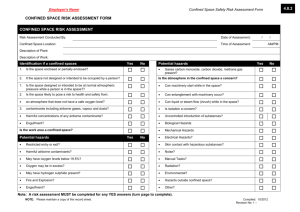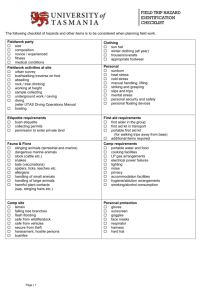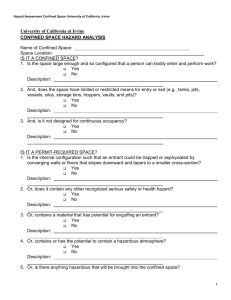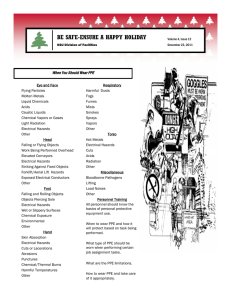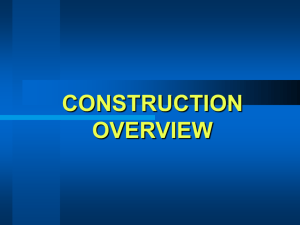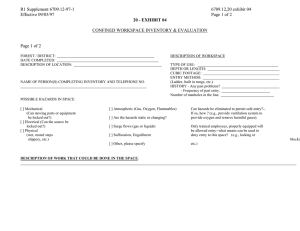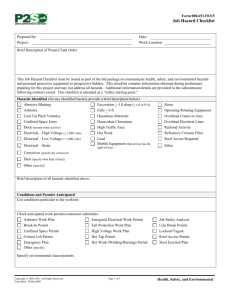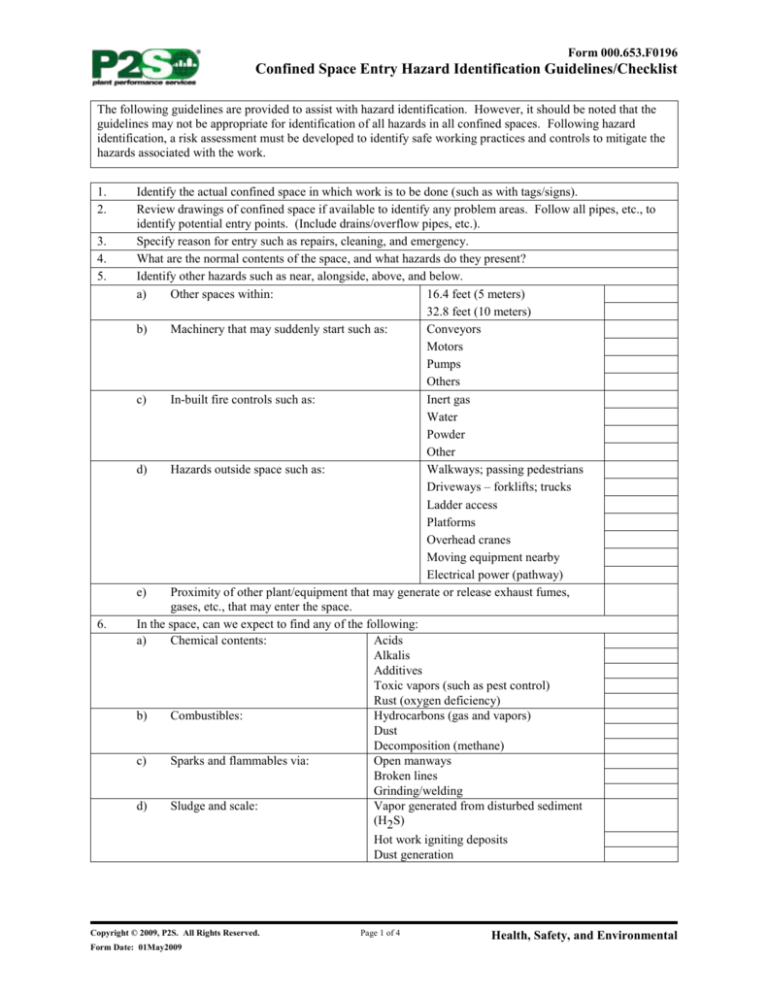
Form 000.653.F0196
Confined Space Entry Hazard Identification Guidelines/Checklist
The following guidelines are provided to assist with hazard identification. However, it should be noted that the
guidelines may not be appropriate for identification of all hazards in all confined spaces. Following hazard
identification, a risk assessment must be developed to identify safe working practices and controls to mitigate the
hazards associated with the work.
1.
2.
3.
4.
5.
6.
Identify the actual confined space in which work is to be done (such as with tags/signs).
Review drawings of confined space if available to identify any problem areas. Follow all pipes, etc., to
identify potential entry points. (Include drains/overflow pipes, etc.).
Specify reason for entry such as repairs, cleaning, and emergency.
What are the normal contents of the space, and what hazards do they present?
Identify other hazards such as near, alongside, above, and below.
a)
Other spaces within:
16.4 feet (5 meters)
32.8 feet (10 meters)
b)
Machinery that may suddenly start such as:
Conveyors
Motors
Pumps
Others
c)
In-built fire controls such as:
Inert gas
Water
Powder
Other
d)
Hazards outside space such as:
Walkways; passing pedestrians
Driveways – forklifts; trucks
Ladder access
Platforms
Overhead cranes
Moving equipment nearby
Electrical power (pathway)
e)
Proximity of other plant/equipment that may generate or release exhaust fumes,
gases, etc., that may enter the space.
In the space, can we expect to find any of the following:
a)
Chemical contents:
Acids
Alkalis
Additives
Toxic vapors (such as pest control)
Rust (oxygen deficiency)
b)
Combustibles:
Hydrocarbons (gas and vapors)
Dust
Decomposition (methane)
c)
Sparks and flammables via:
Open manways
Broken lines
Grinding/welding
d)
Sludge and scale:
Vapor generated from disturbed sediment
(H2S)
Hot work igniting deposits
Dust generation
Copyright © 2009, P2S. All Rights Reserved.
Form Date: 01May2009
Page 1 of 4
Health, Safety, and Environmental
Form 000.653.F0196
Confined Space Entry Hazard Identification Guidelines/Checklist
7.
10.
Will other chemicals be introduced to the space for other purposes such as:
a)
Cleaning, painting, stripping, and neutralizing?
b)
Are material safety data sheets available for them?
a)
Atmosphere.
Oxygen deficiency
Oxygen enrichment
Toxic (PPM)
Explosive
Flammable
LEL percent
b)
Continuous monitoring of the
Is required
environment:
Is not required
c)
Ventilation:
Is required
Is not required
Any dead spots
Natural
Forced
Mechanical
Exhaust waste air to
d)
Entry will be safe under the
Natural ventilation
following conditions:
Mechanical ventilation
With supplied air/airline
With self-contained breathing apparatus
Without respiratory protection
Entanglement; moving machinery
Uncontrolled substances.
Steam
Water
Chemicals
Others
Electrical hazards.
11.
Noise.
8.
9.
Generated within the space
From outside the space
12.
Manual handling.
Size of load
Posture
Small spaces
Room to move
13.
Temperature extremes.
Hot
Cold
Copyright © 2009, P2S. All Rights Reserved.
Form Date: 01May2009
Page 2 of 4
Health, Safety, and Environmental
Form 000.653.F0196
Confined Space Entry Hazard Identification Guidelines/Checklist
14.
Lighting.
Natural
Will be required
Nearest power supply (local/portable)
Emergency
Backup (battery)
Voltage
Earth leakage protection
15.
Communication.
Voice
Radio
Telephone
Line
Visual
16.
Personal protective equipment.
17.
Eye
Hearing
Foot
Head
Body
Hand
a)
Respiratory:
Cartridge
Airline
Self-contained
b)
Fall protection:
Safety harness
Inertia reel
Static line
Safety line
Other
Hot work – any special conditions that may apply such as Hot Work Permit.
18.
Psychological.
19.
Slips, trips, and falls.
20.
Access into and within the space.
Copyright © 2009, P2S. All Rights Reserved.
Form Date: 01May2009
Page 3 of 4
Health, Safety, and Environmental
Form 000.653.F0196
Confined Space Entry Hazard Identification Guidelines/Checklist
21.
22.
Note:
Isolation.
Identify problem areas such as:
Pipes
Ducts
Vents
Drains
Conveyors
Bleed back
Fire protection equipment
Confirm that isolation can be achieved such as remove valve, insert blank/spade, cap/plug pipe, double
block, and bleed.
Identify deenergization requirements such as:
Springs
Wheels
Hydraulic rams
Pneumatics
Belts
Thermal
Conveyors
Mechanical
Electrical:
Remove fuses
Lockout
Tagout
Will you require?
Sign posting
Barriers
Barricades
Witches hats
This form is referenced in Practice 000.653.3322.
Copyright © 2009, P2S. All Rights Reserved.
Form Date: 01May2009
Page 4 of 4
Health, Safety, and Environmental

